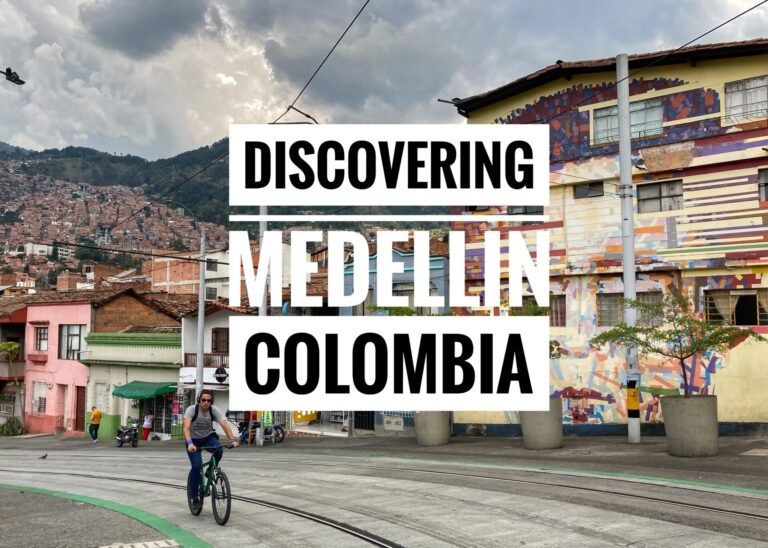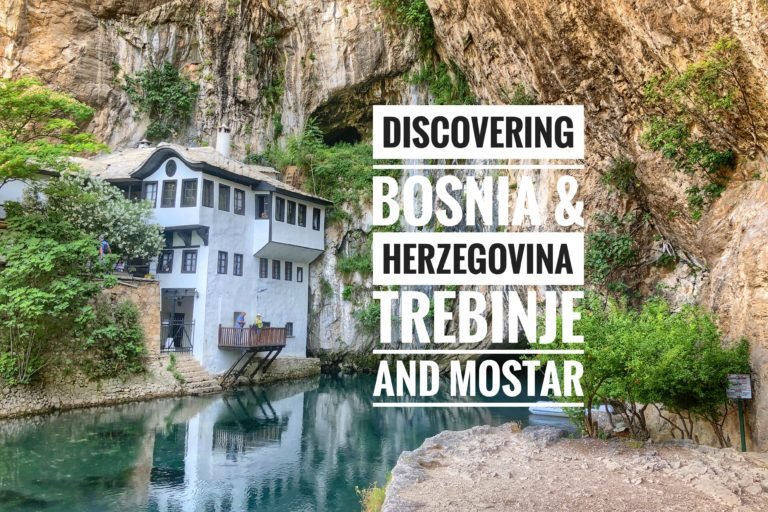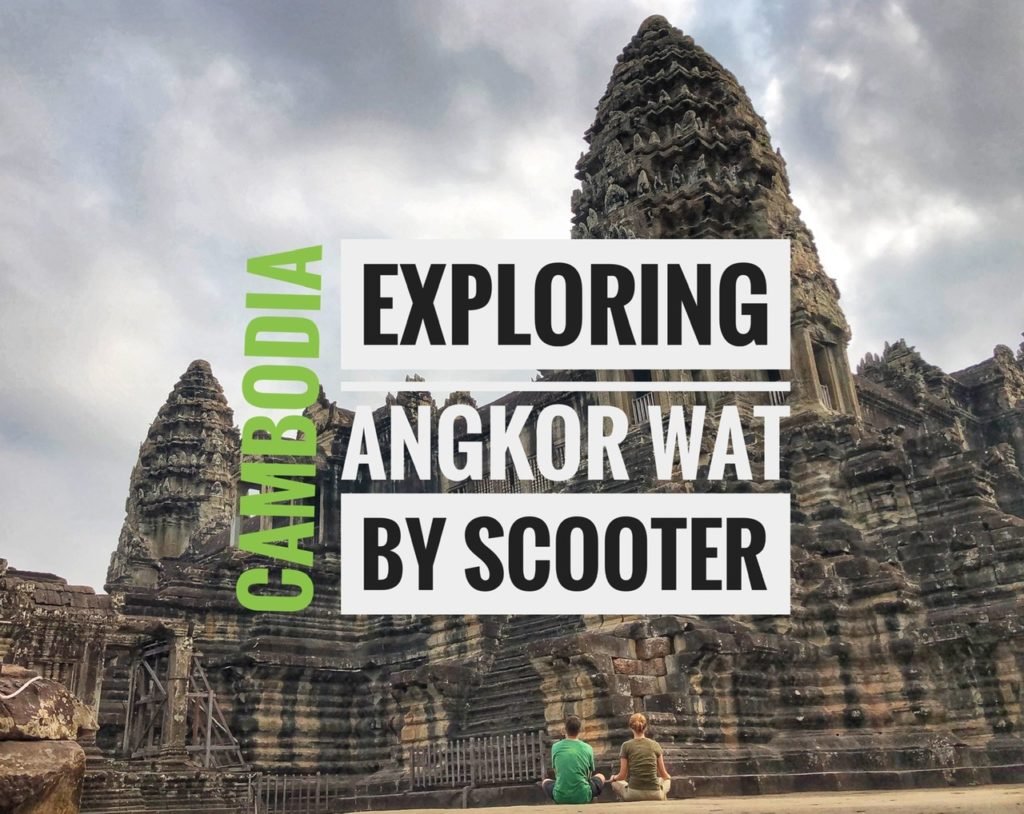
It doesn’t matter how many times you’ve seen it in movies or pictures, getting a glimpse of the UNESCO world heritage site of Angkor Wat in person rendered us both speechless. An awe took over our bodies with seeing something so truly magnificent, practically turning us to jelly. But Angkor Wat is so much more than just one temple complex, which everyone recognizes and rightfully marvels at. The sheer size and magnitude of what was built at the whole of the Angkor Wat site, is what quickly becomes incomprehensible. Built in 12th Century AD, this complex is actually the largest religious monument in the world at an astounding 154 square miles.
Angkor Wat typically sees 2.6 million visitors a year, and is well documented to be thronged and chocked with tourists. In fact, Fodors travel in 2018 incredibly placed it on their DO NOT go list because of the irreparable damage that the swarms of tourists are doing to the site. But, for us, being there during just as the current global COVID-19 pandemic was ramping up, meant we had a very different, and quite abnormal visit. The closest thing we could compare it to was kind of like having an exclusive fast pass to enter Disneyland before it officially opens to the masses. But better. Much much better. The spoils didn’t just stop with lack of crowds, or lines, or strangers photobombing us, Cambodia was also offering discounted entry (2 days instead of one for $37, or 5 days if your buy 3).
With the Angkor Wat complex being as dauntingly huge as it is, most people decide to take guided tours of Angkor Wat and leave the logistics up to their guide. We decided, however, that our best option for exploring the complex with the flexibility and independence that would match our timetable was to get a set of wheels…rent our own motorbike, and do it ourselves, bopping along dirt roads and doing what we do best… exploring. In the end, it all was nothing short of magical. And we couldn’t have asked for a better experience.
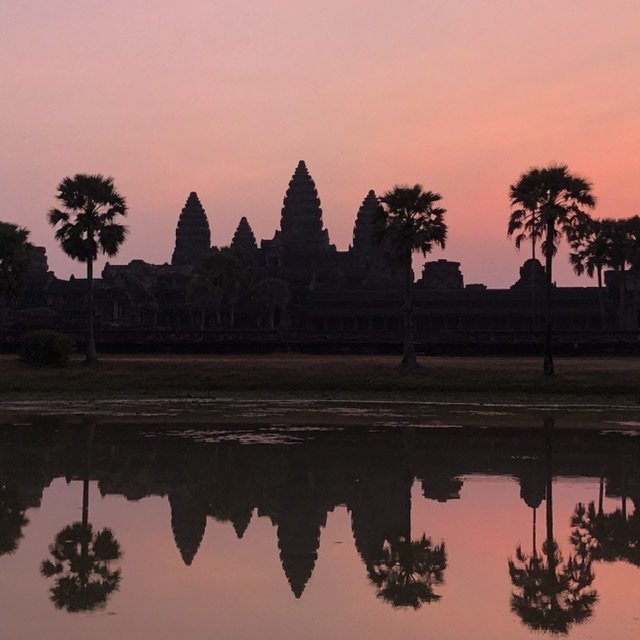
Experts recommend you be at the doors when they open by 5:30 to have a chance of getting a seat next to the main Angkor Wat reflection pool in time for a spectacular sunrise. Having a motorbike saved us a little time and allowed us to sleep in a bit, getting there at 6 instead. At that time, there were probably a couple hundred people there, but the numbers are usually much higher, even in the thousands. With the smaller crowd it was incredibly easy to wiggle our way to a front row seat, plopping ourselves down by the pool to await the show.

The sun never rose up from behind the ruins, as we had expected. We we did get was a radiant pink and magenta sky which beautifully silhouetted Angkor Wat. The name, Angkor Wat means “city of temples.” This is the actual “real” Angkor Wat, and main complex which served as the capital, and the surrounding temple complexes were other nearby “cities”.
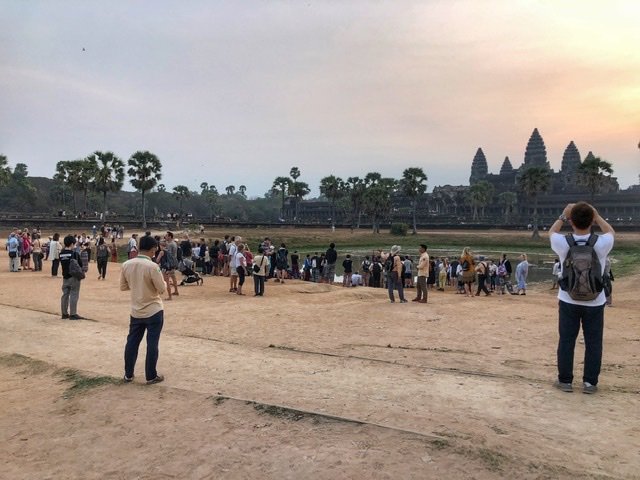
The crowd we experienced… A guard we asked said this area was normally completely covered in people.

Of course, us DIYers parking next to the hired tuk tuks resting in their hammocks until their patrons returned was a little awkward. They understandably are not fans of “self-guiders” like us, for obvious reasons.
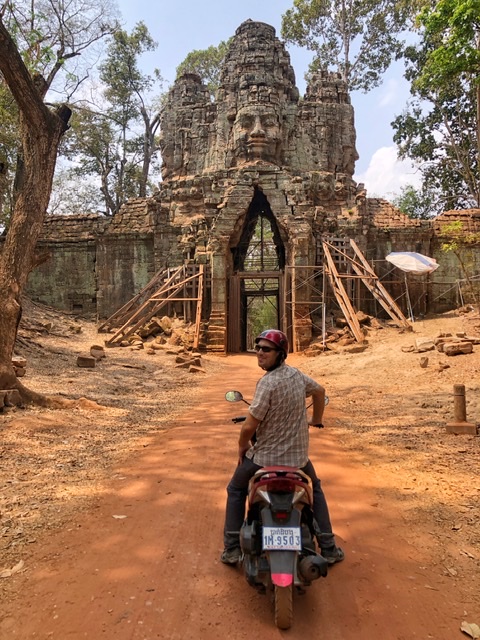
Our motorbike, which ended up fueling our erratic explorations of Angkor Wat, was just ($13/day). If you prefer instead to let someone else do the driving, you can also explore the complex by rented Tuk tuk with driver, tourist van, or regular bike. Although we looked at the bike option ($3/day) we both quickly concluded trying to do the enormous site by pedal power just seemed insane in the tremendous tropical heat, plus the distances you need to cover are not for the causal cyclist. The most common sightseeing circuit of Angkor Wat is about 40km. So, we quickly realized we made the right decision to go motorized. Here we are next to the west gate, which we discovered by complete accident, that lead us into a magnificent “secret” (no tourists!) entrance to the park.
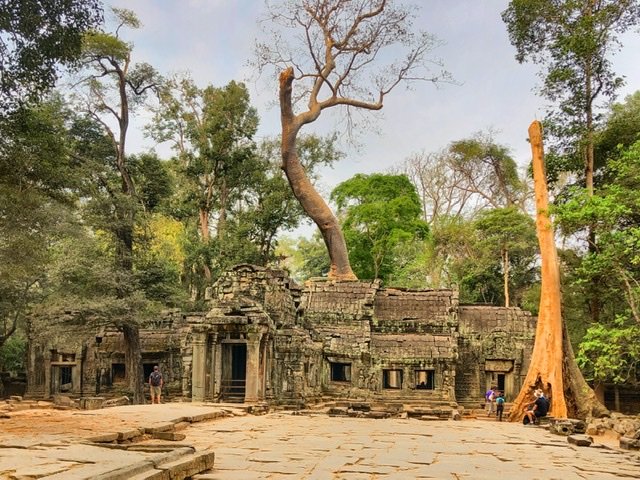
Ta Prohm
After Sunrise at Angkor Wat, we headed immediately to Ta Prohm temple, hoping to “beat the crowds” rather than following them straight into visiting the interior of Angkor Wat. It turned out to be a smart move. There were less than a dozen people here when we arrived at 7:45 am at the entrance to Ta Prohm. The temple is more commonly referred to as the Tomb Raider Temple due to its appearance in the 2001 Lara Croft movie. Paramount was charged US $10,000 per day for seven days to film there and this filming, has caused Ta Prohm to explode in popularity ever since.

Entering Ta Prohm is simply otherworldly. Its enchantment lies in the fact that, unlike most other monuments of Angkor, it has been swallowed by the jungle, and giant trees have been allowed to continue to grow in amongst the ruins giving it an appearance perhaps close to the way most of the monuments of Angkor appeared when European explorers first stumbled upon them.
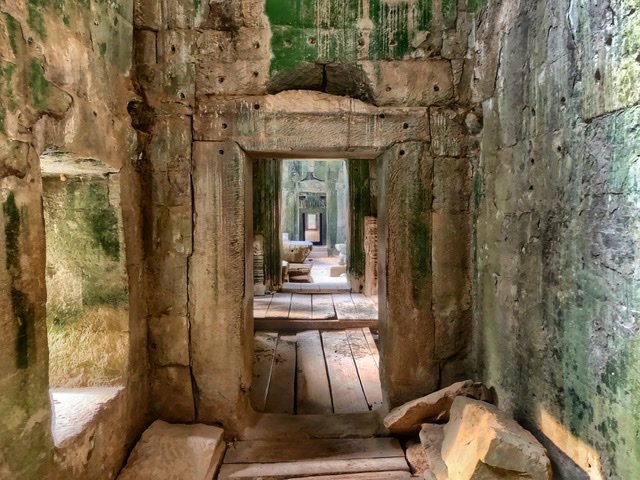
The aesthetics of the symmetric doorways and window frames are simply striking and difficult to comprehend. The words, “how did they do this…” were on a constant repeat. With sweeping long, and perfectly aligned corridors built with immense sculpted boulders and, in our case, no one else present it gave us an almost eerie feeling of being trapped in a fictional fantasy world. What a perfect set for Hollywood!
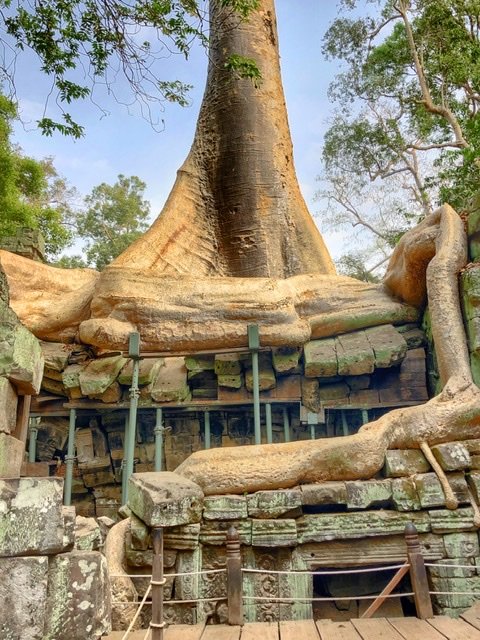
This giant strangler fig tree clearly has no problem showing the structure that nature, not man, is boss.
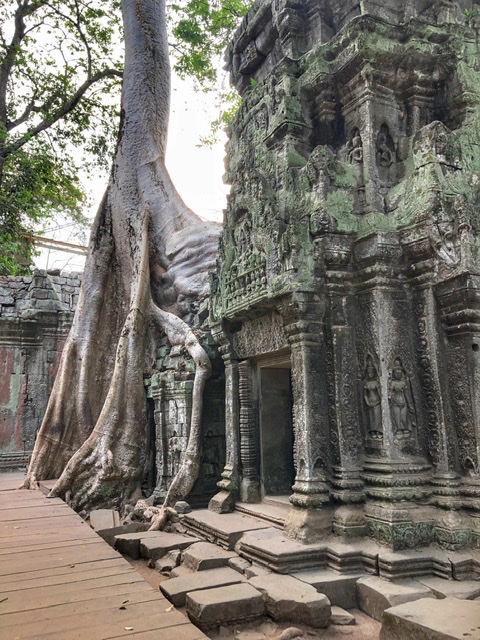
There is something so magically harmonious about the way nature and man’s work serendipitously weave together at Ta Prohm. In an ironic way, many of the trees latticework of the roots have helped to preserve and protect the architecture and intricately carved stonework at Ta Prohm by Saving them from centuries of weathering.
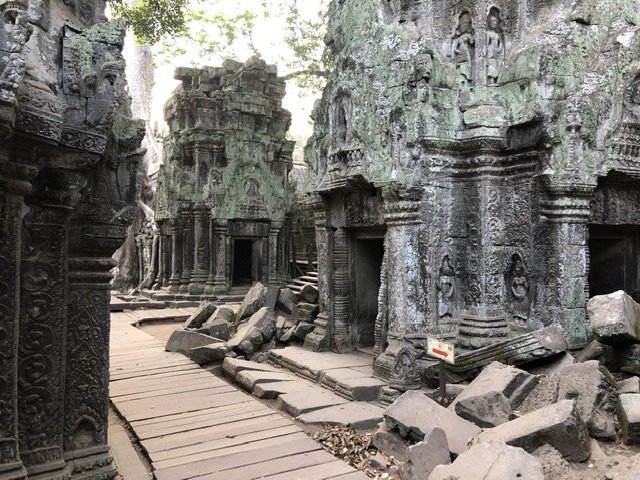
Khmer stone bricks used to construct the complex were bonded together, almost invisibly, by using a vegetable compound rather than mortar.
Angkor Wat was shifted from Hindu to Buddhist use sometime around the late 13th century. The temples are still used by Buddhists as an active place of worship today.
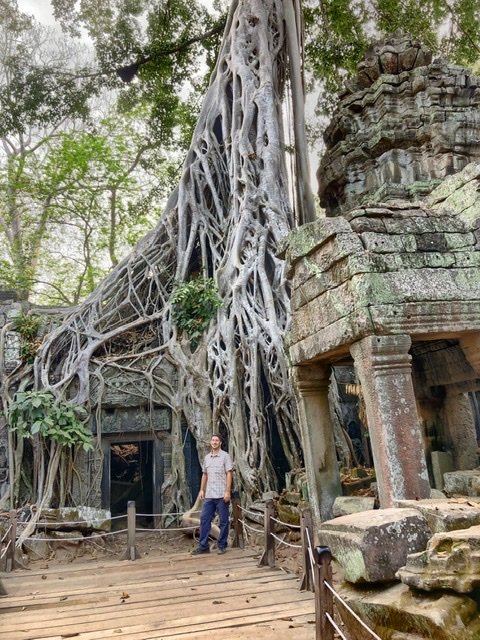
Greg stands in one of the many iconic spots where on a normal day a substantial queue would have formed.
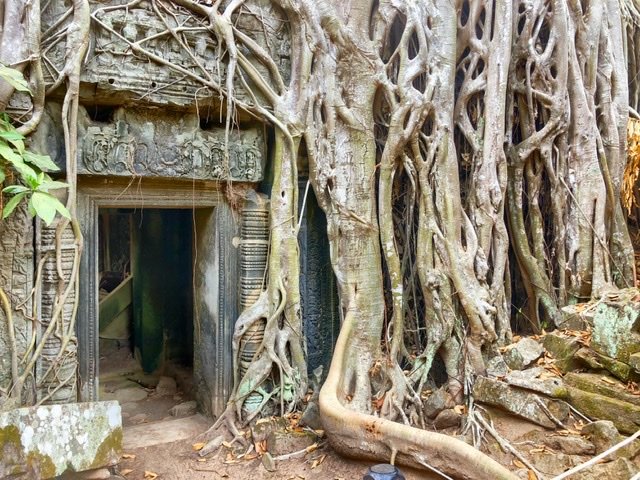
According to Lonely Planet, “Built from 1186 and originally known as Rajavihara (Monastery of the King), Ta Prohm was a Buddhist temple dedicated to the mother of Jayavarman VII. It is one of the few temples in the Angkor region where an inscription provides information about the temple’s dependents and inhabitants. Almost 80,000 people were required to maintain or attend at the temple, among them more than 2700 officials and 615 dancers.”
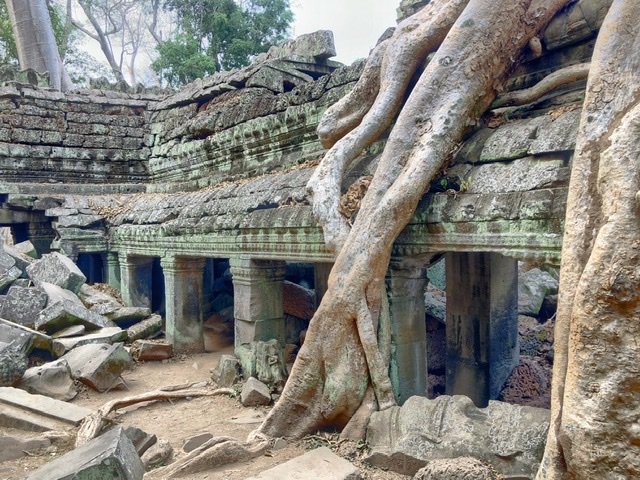
An image you’ve probably seen before.
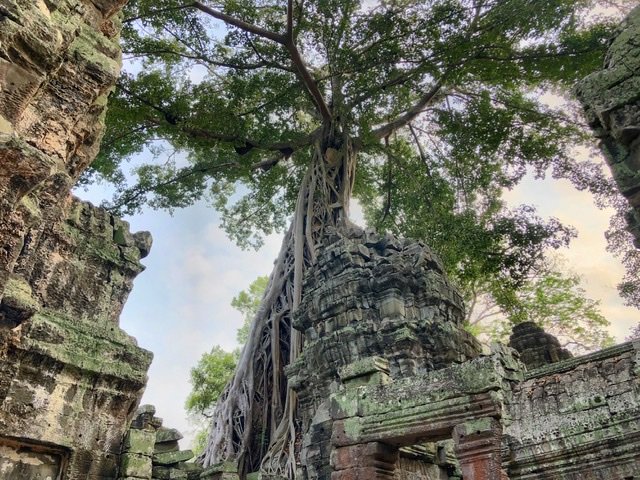
The trees taking back over was a beautiful kind of poetic justice.

Ah, and here we stumbled on one of the most thought-provoking modern-day mysteries of Ta Prohm. Look closely at this image of an animal. If you see a Stegosaurus, then the mystery quickly becomes clear… and your mind perhaps begins to be blown. According to Atlas Obscura… “Several different theories have been advanced to explain its presence. Some maintain it’s a recently-carved hoax, while others say that the ancient Khmers could have unearthed a fossil and figured out what kind of creature it belonged to.
One theory has it that the image actually shows a cow or rhino with a palm tree in the background – the palm’s fronds being easily mistaken for the fin-like blades running down a stegasaurus’ back. Or maybe the carving is evidence that dinosaurs really did live on until much later than previously thought. (Creationists would certainly like to believe so.) Perhaps here in the humid, ancient jungles of Southeast Asia, where the climate has remained largely unchanged since the dinosaurs’ days, giant reptiles lived on well into the human era – long enough to persist in the Khmer folk-memory.” Well, if only these walls could talk, we might have a clue, but in a place like this, we prefer to let our minds wander into fantasyland …

What an absolute marvel!

The sun finally bursts through the sky for this extraordinary moment. This is the one photo, of the hundreds that day where we got the feeling we actually captured a sense of how truly remarkable this place is.

A majestically long, and magically sunlit, corridor sweeps the front entrance to Ta Prohm.

Banteay Kdei
Every temple complex at Angkor has a different feel and character. Moving onto the nearby gate of Banteay Kdei temple. Similar in layout to Ta Prohm, but because Banteay Kdei was frequently used as a religious temple until the 1960’s, it lacks much of the overgrown jungle atmosphere found at Ta Prohm.
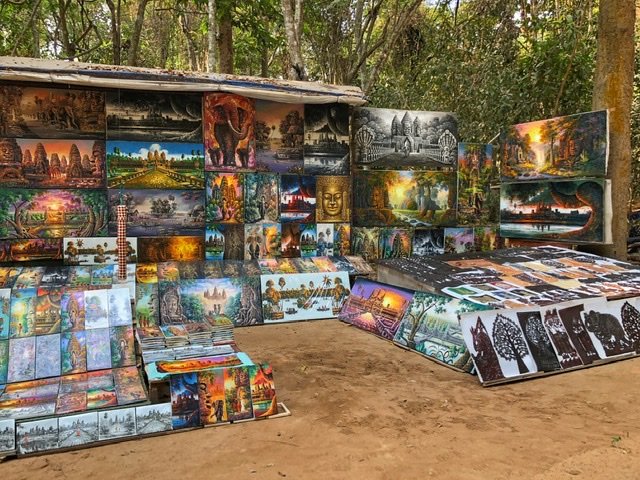
The local painters sell striking masterpieces for ridiculously low prices, less than $5. If were headed to a home after here, it would be difficult to resist buying a couple.
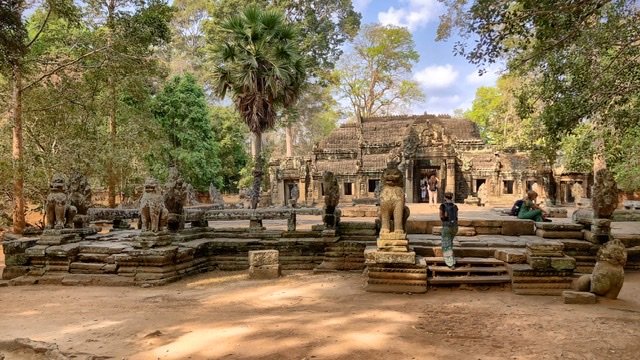
The entrance to Banteay Kdei.
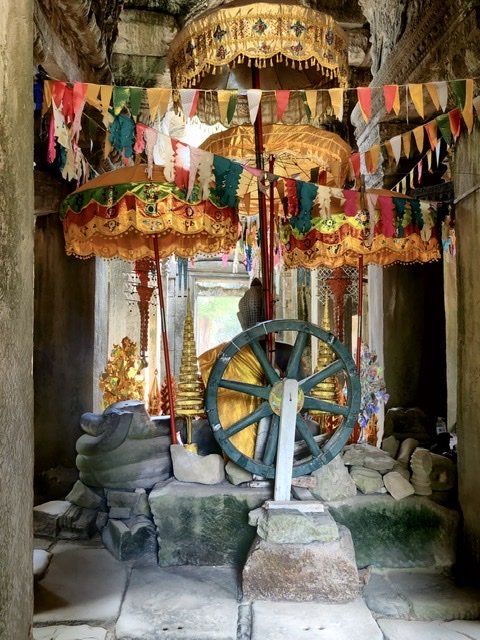
Buddha shrines dot many of the temples we visited.
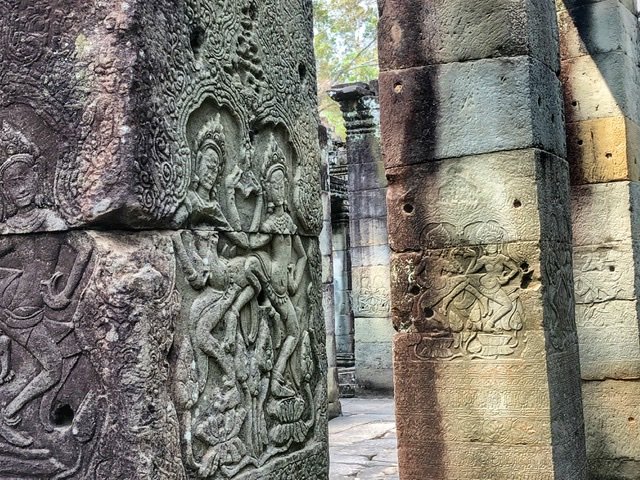
The unique character of Banteay Kdei temple was helped along by its playful “Hall of the Dancers”, reliefs or asparas that don its pillars and exterior walls. Aspara dancers are women who narrated classical myths or religious stories. This exquisite type of traditional dancing can still be viewed in Cambodia today.
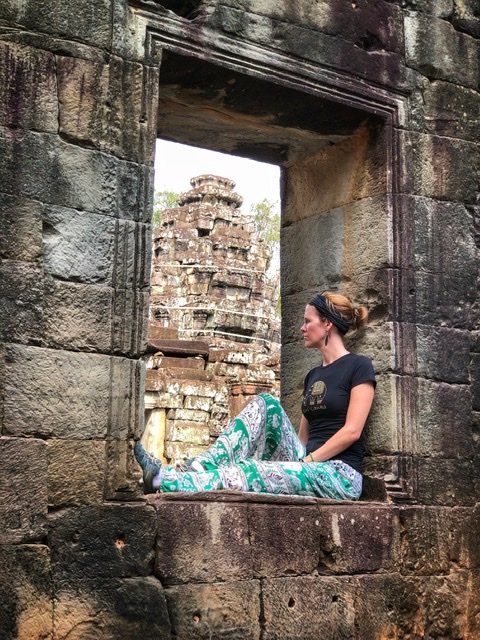
Mandy takes a moment to take it all in.

It’s hard not to conjure up Indiana Jones in this place.

Ta Keo and Chau Say Tevoda
Moving on, we went to “hike” up Ta Keo, a sandstone mountain masterpiece and one of the tallest monuments of Angkor and is said to represent Mount Meru, the mountain that is the center of the world in Hindu mythology. Its five sanctuaries are placed on top of a 22-meter high five stepped pyramid, from where there are good views of the surrounding area.
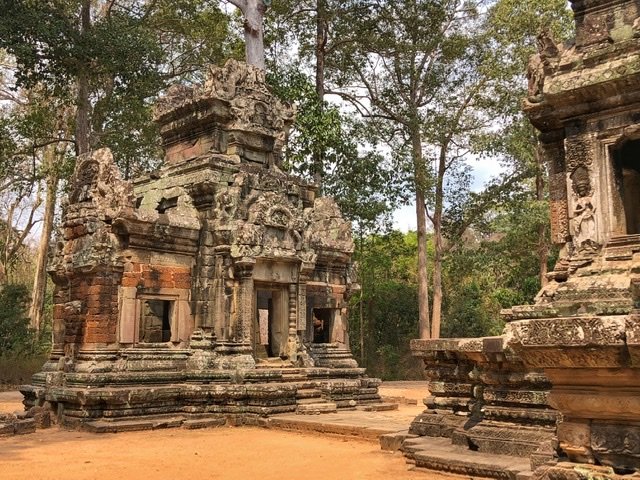
Chau Say Tevoda Temple was completely secluded.
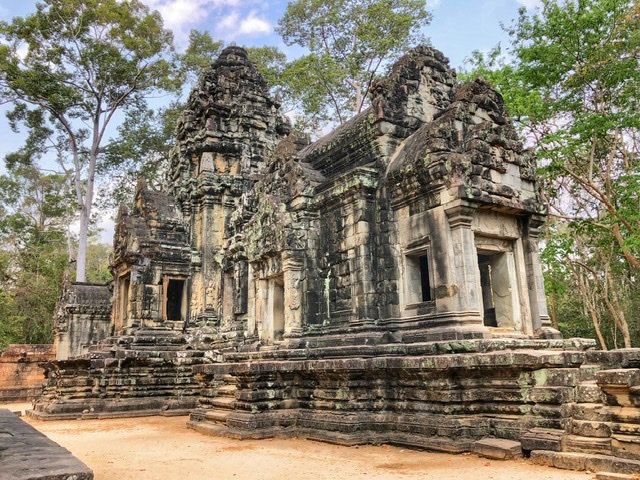
We got to enjoy it all on our own. But as much as we wanted to stay it was high noon, blazing hot, and time to ride the 8k back for a break at our hotel.
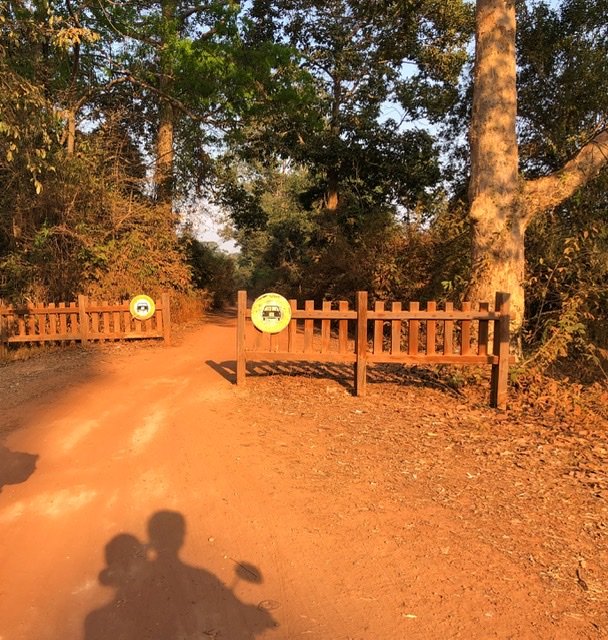
The entrance gate to the “secret” west entrance. Well worth it adventurers!!
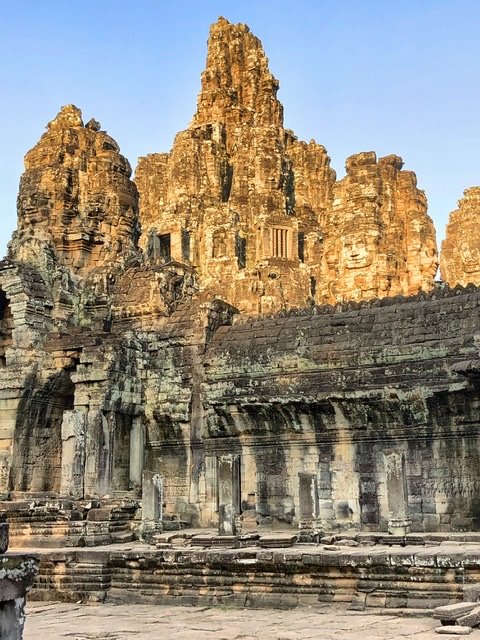
Bayon Temple
How many faces can you find?! The other most popular site at Angkor is the richly decorated Bayon Temple. Commonly heard to be “the one with all the faces” it epitomises the creative genius and inflated ego of Cambodia’s most celebrated king, Avalokiteshvara. We considered it the most captivating of all the temples when we visited. When we got there at about 4:30 pm, it was just an hour before it closed. We chose wisely. Being so close to closing, It became utterly spellbinding to experience it all on our own and get lost in the countess corridors and hallways, seeing only one other couple (who startled us!) the whole time.
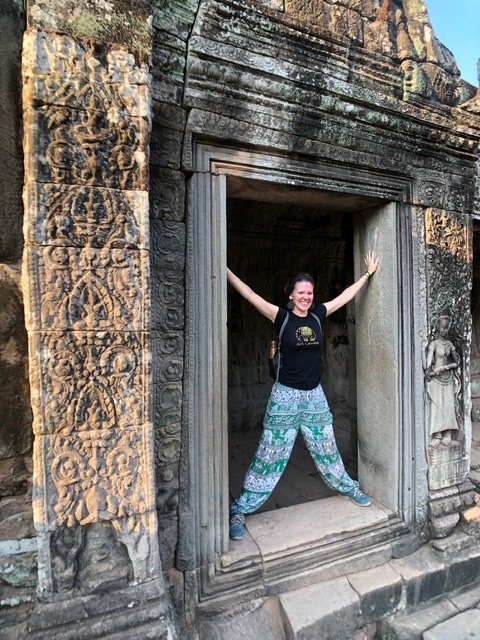
No people means lots of time to play!
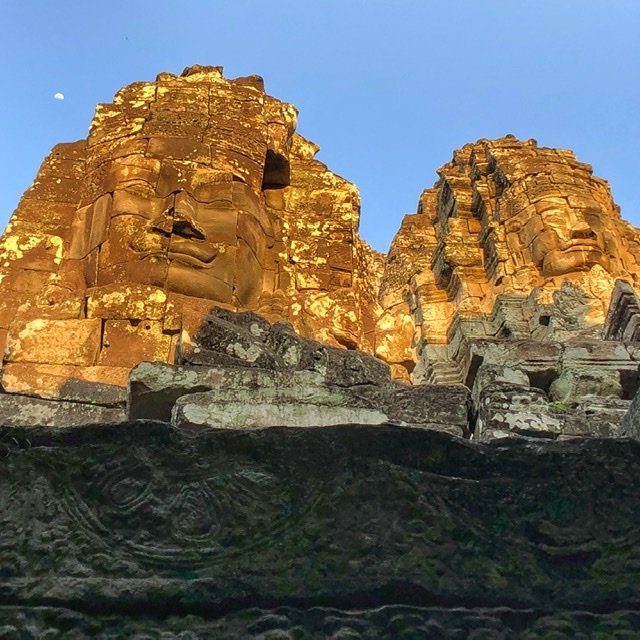
Unfortunately the upper deck is closed until 2022 for renovation so we didn’t get to check the faces out close up.
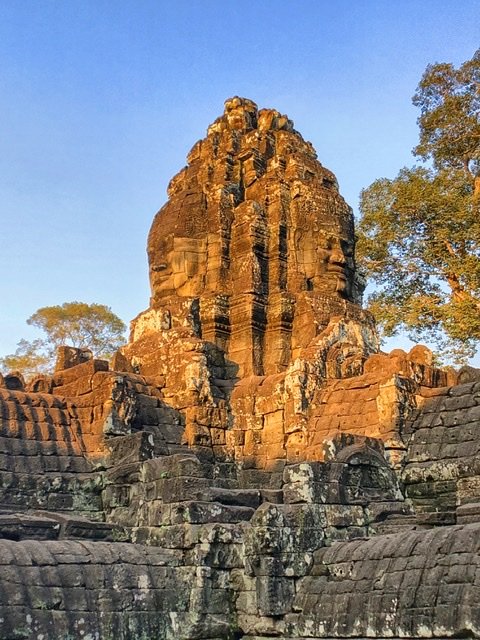
Its 54 Gothic towers are decorated with 216 gargantuan smiling faces of the great king.
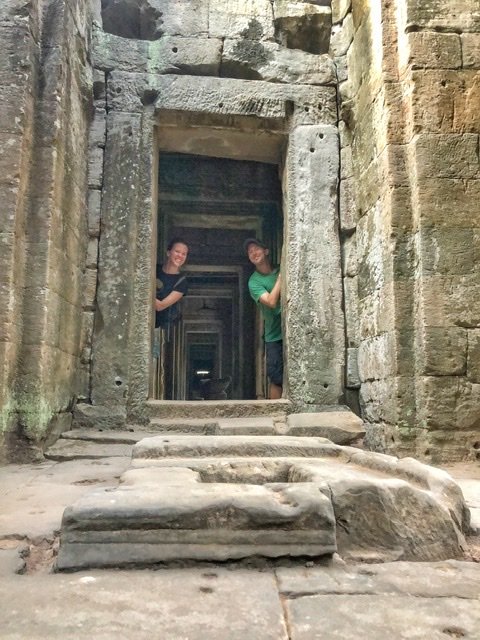
Keep Exploring!!
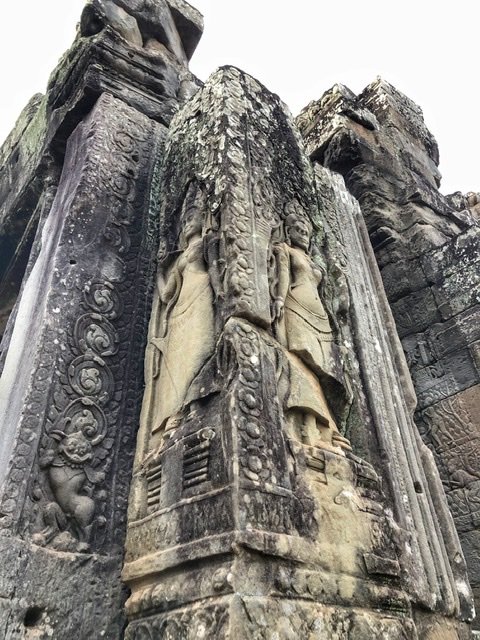
Wow! Just gets better and better!
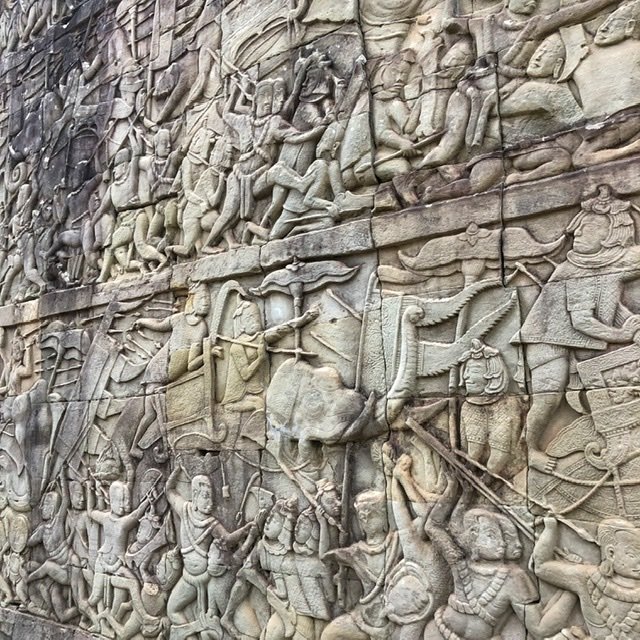
One of the many intricate bas-reliefs within Bayon. We could have wandered this place for hours but unfortunately they started closing up and shooed us out.
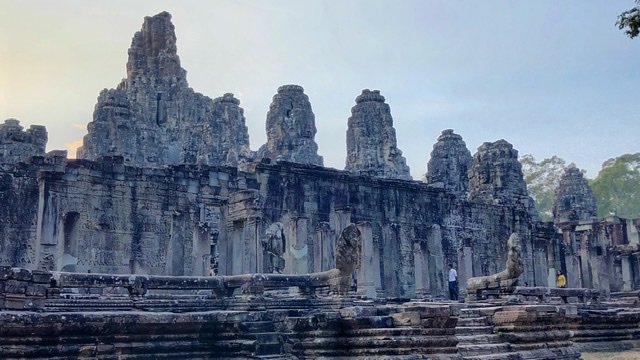
Bayon’s exterior walls
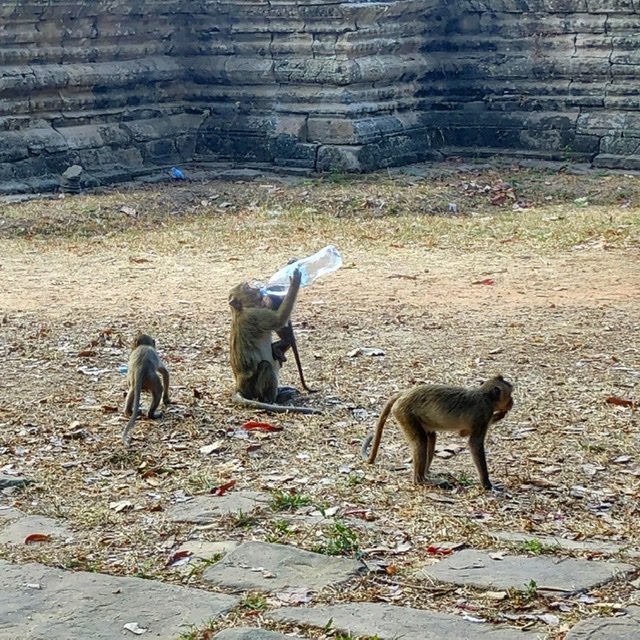
Almost as soon as we exited, this monkey came charging at Mandy and the bottle of water she was swinging. She was so bewildered, she abruptly panic threw the bottle at him to keep him from pouncing. Happily with his prize, and with great efficiency, the monkey unscrewed the bottle, and started downing the water to the envy of all his monkey friends. Poor little thirsty monkeys.

A collection of the remarkable door and window frames from day one.
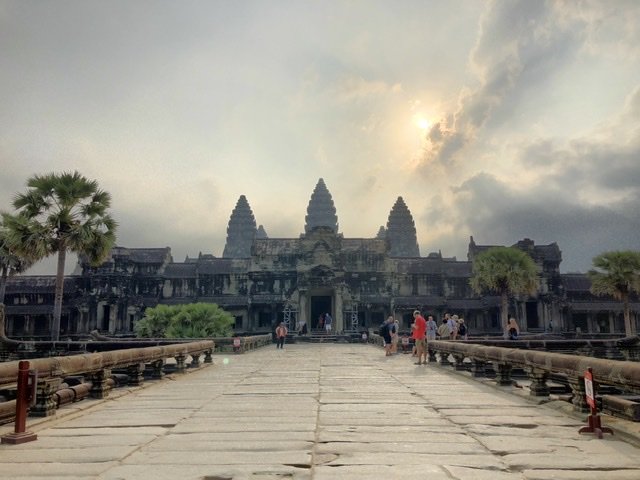
Angkor Wat: Main Temple
The next day we returned to the main temple of Angkor Wat (Capital of Temples) to explore the inside at about 9 am. As you can see from the crowds walking down the entrance promenade, it was starting to pick up. ?
Cambodia is so proud of this icon that they display this image on their flag. Afghanistan is the only other country that has a monument on their flag. It has five tower peaks to represent the five peaks of Mount Meru.
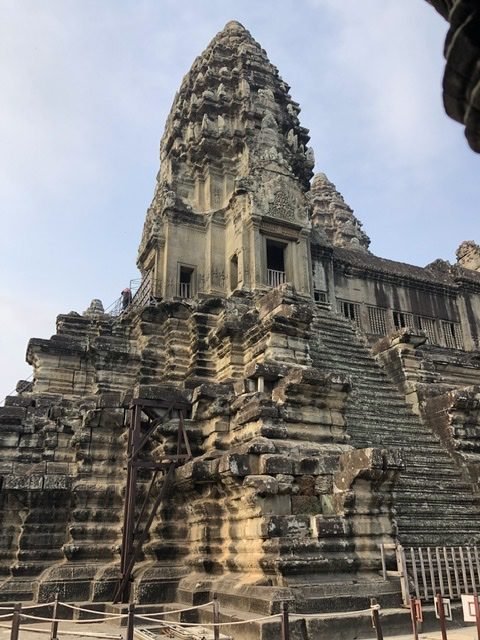
It’s simply incomprehensible that these temples were built without the aid of any machinery. In the late 12th century, it took 35 years to build with the help of approximately 1,000 elephants in addition to the 300,000 labourers.
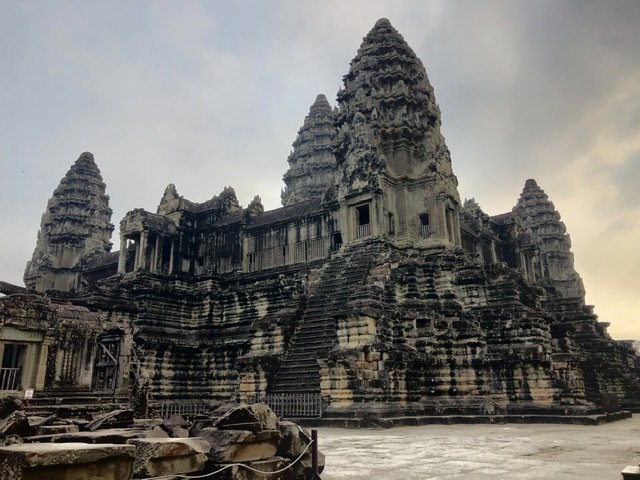
We couldn’t have been more lucky to take it in like this.
Check out the ancient stairs. They are so completely worn you would need climbing gear just to scale them. It was strange to walk directly above them on constructed tourist stairs.
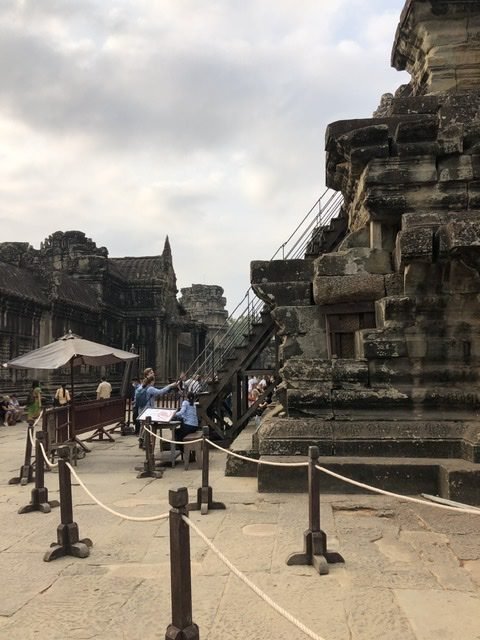
This is the stanchions for the line which goes up the central towers. According to our guidebook, the line usually takes 45 minutes to an hour. In the beating sun, it was surreal to just walk right up.

Notice the ribbon pillars in the window frames. This is a classic style of Khmer architecture. It is still used in Khmer architecture today often using wood instead of sandstone.
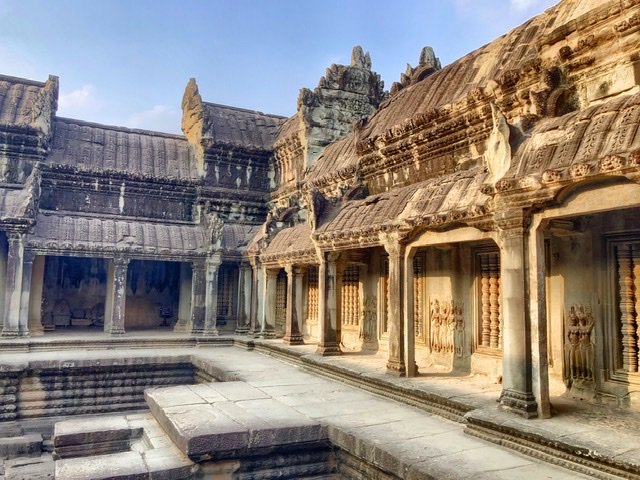
In one of the upper courtyards.
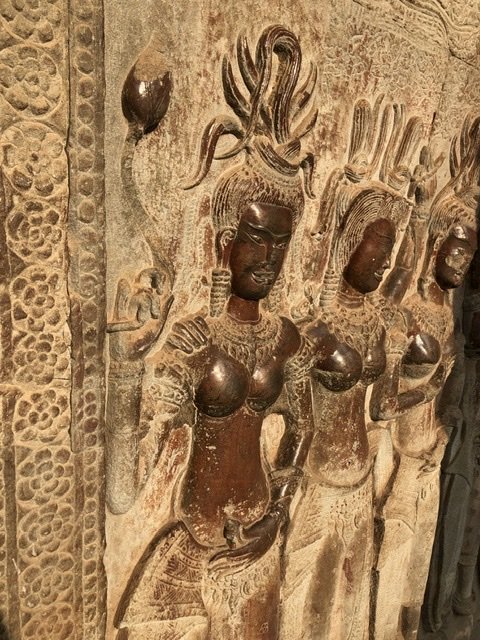
Most of the bas reliefs at Angkor Wat represent Hindu mythology.
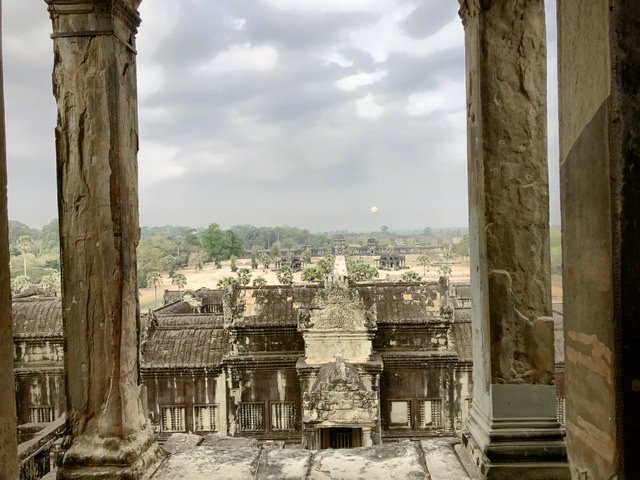
The view from the towers looking toward the main promenade. In the distance you can see the balloon which takes people up and down for a view of the temple from above.
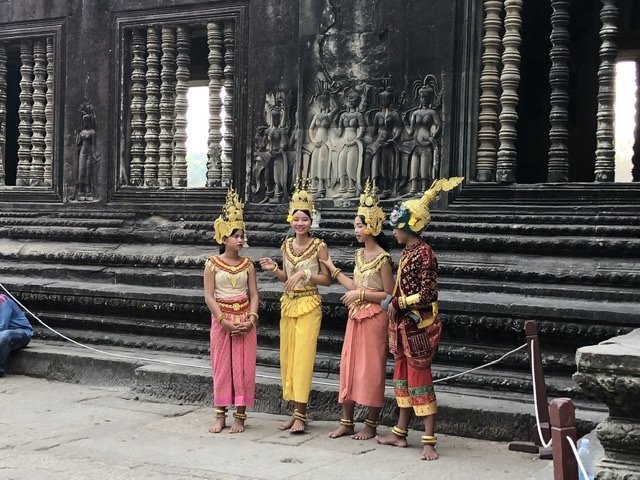
A group of Aspara dancers get a break from the tourist rush. Love the contrast of them in front of the bas reliefs.
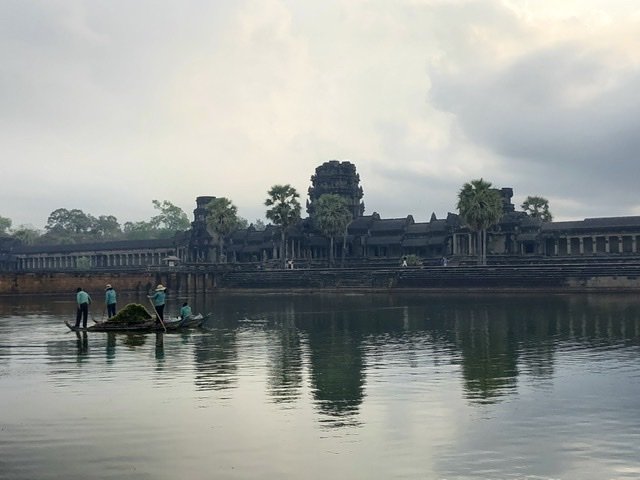
An interesting feature of Angkor Wat is that it is surrounded by a moat which is 200 meters wide, 4 meters deep and has the perimeter of around 5 km. Many of the temples are surrounded by moats of this breadth.
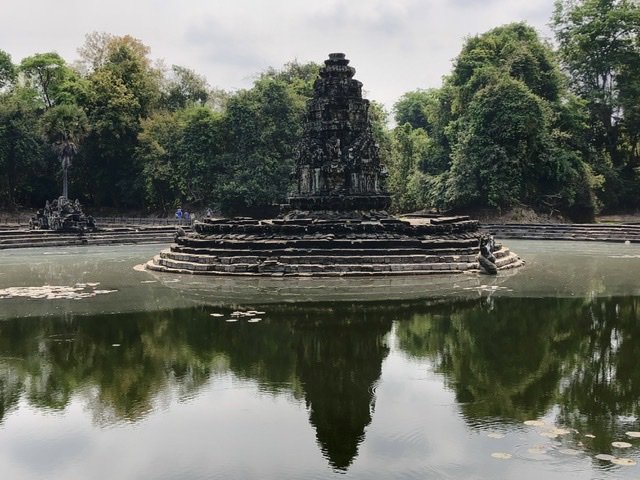
Neak Poun
Another such moat encompasses the temple of Neak Poun, which is a Buddhist temple on an artificial island, surrounded by a pond. (Seriously, how did they build an artificial island in 12th century?) Neak Pean was originally designed for medical purposes (the ancients believed that going into these pools would balance the elements in the bather, thus curing disease.)
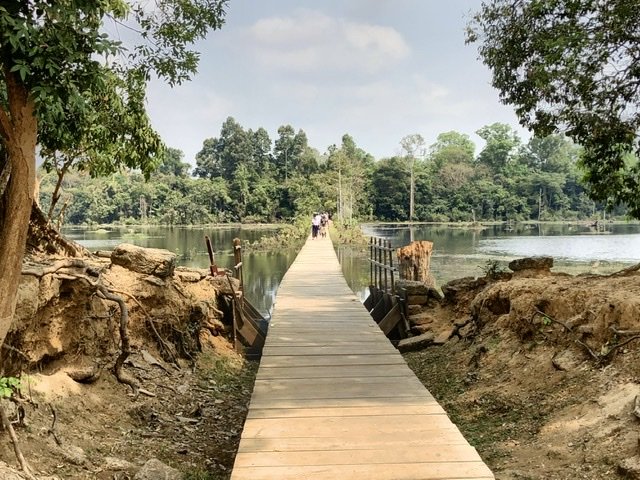
The long boardwalk to walk out to Neak Poun.
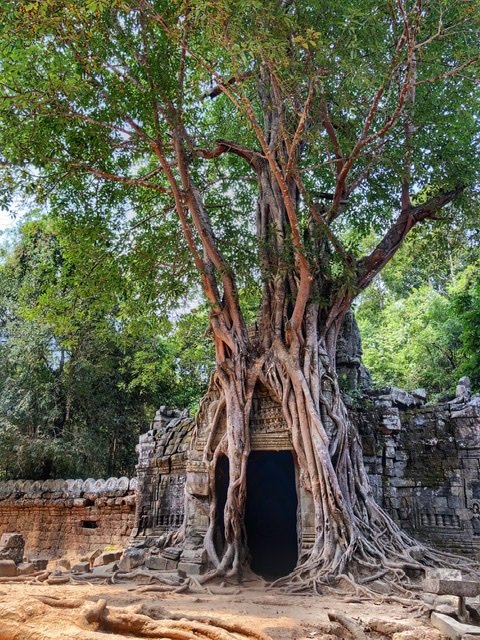
Ta Som Temple
Ta Som Temple, the furthest one of the Grand Circuit which means often the most isolated. It’s famous for this fir tree growing out of it.
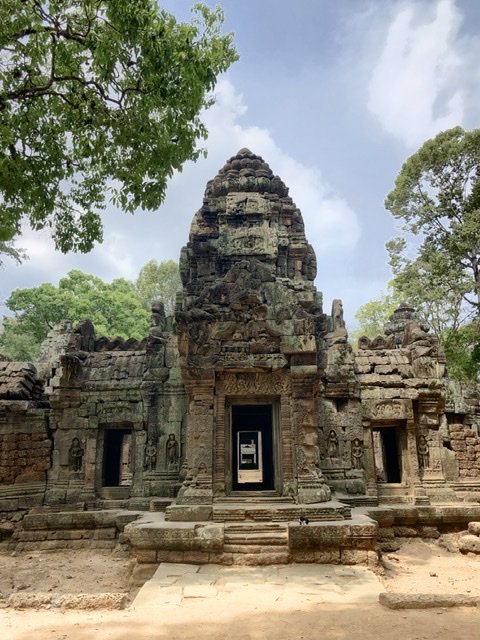
The entrance to Ta Som.
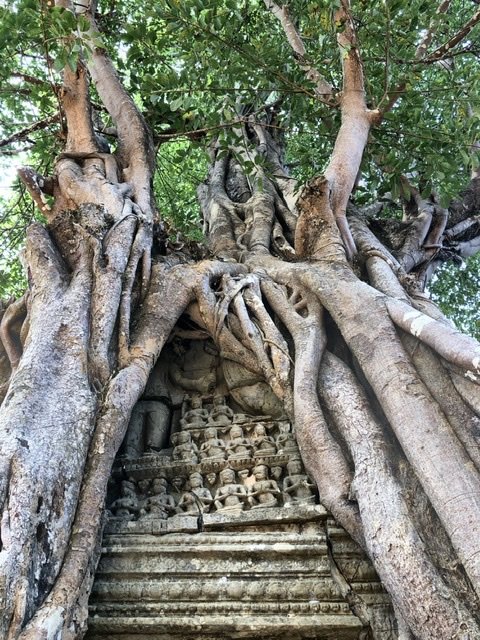
Nature acts as a theatre curtain unveiling the next act.

Preah Khan Temple
By the time we got to Preah Khan Temple, we were getting ruin fatigue so we missed some of the best parts, but we did enjoy the endless symmetric corridors!

This flat leveled building once was once used as a university.

Wonder if this was one of the teachers ?
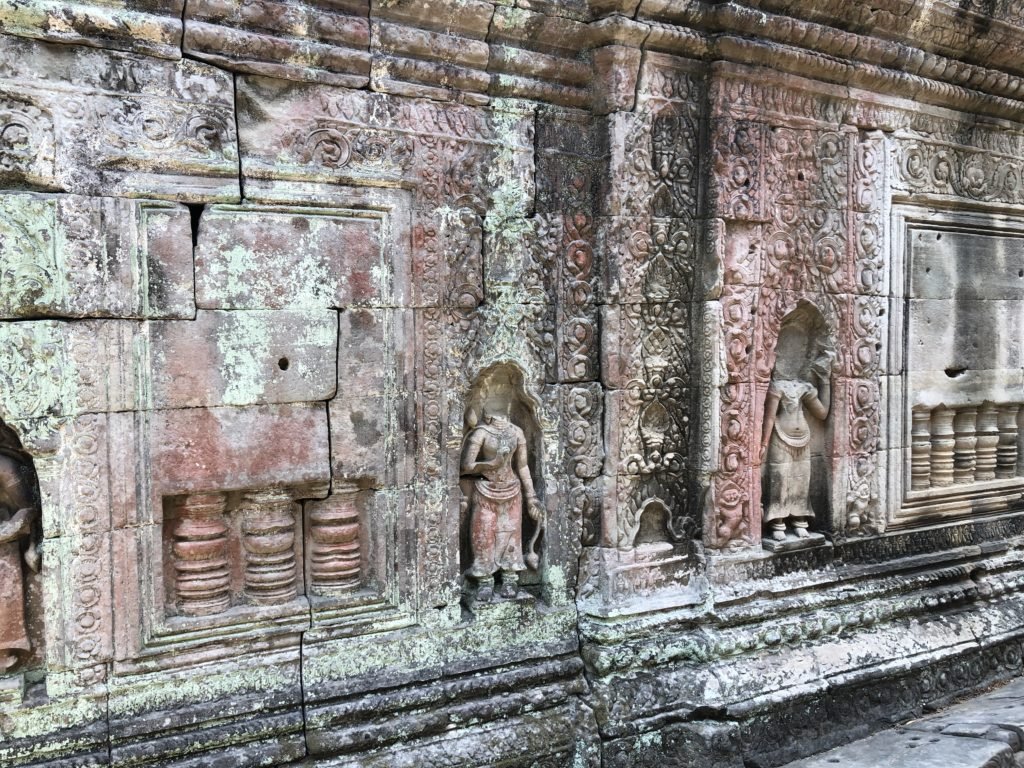
It was fun to explore but with the sun baking down we were more than ready to move on.
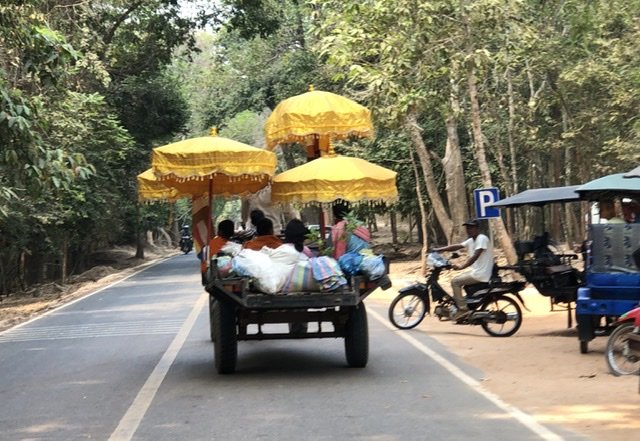
These monks know how to travel in style!
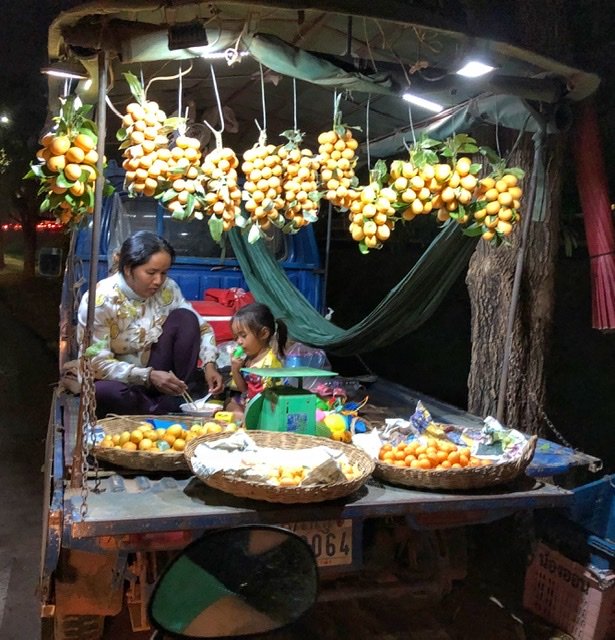
Stopping to buy the most adorable baby mangoes from this mother and daughter on the side of the road.


